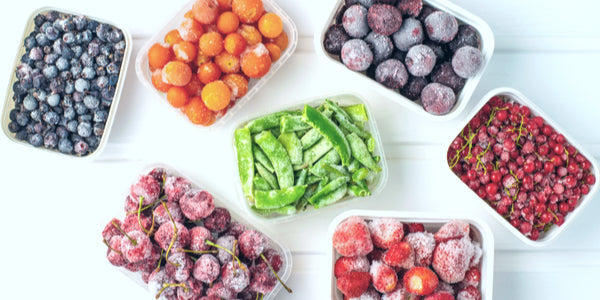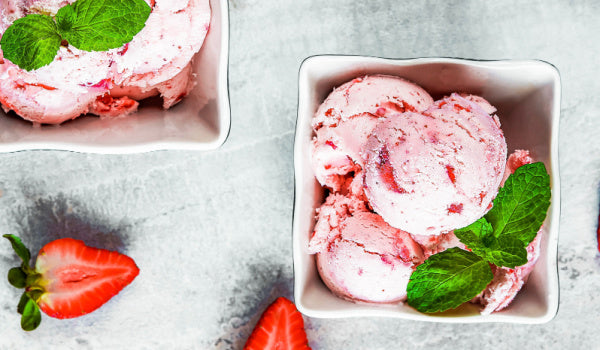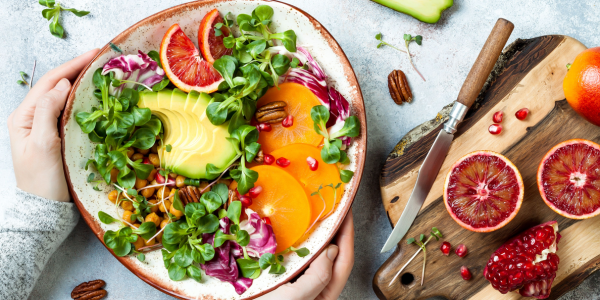
Frozen food is not a new concept. But it is not always welcomed by consumers and health enthusiasts alike.
However, frozen foods and meals are much more than box dinners presumed to be. In fact, they can even be advantageous to health, as well as to the economy.
We explore what frozen food actually entails while naturally debunking common misconceptions and highlighting their benefits.
After clearing the air, learn how to properly store and select the healthiest frozen food as well!
What Is Frozen Food?
Simply stated, frozen food is food that has undergone freezing and is kept frozen and preserved until used. The freezing process slows down decomposition by turning excess moisture into ice and inhibiting bacterial growth.
Freezing is a common practice throughout households and the food industry. Freezing tends to be slower at home, while the food industry tends to use quick processes such as flash freezing.
Despite such advances in freezing technology, people tend to misconstrue the nature of frozen foods.
Common Misconceptions About Frozen Food
Many misconceptions surround frozen foods and give them a negative rep. Can you decipher fact from fiction when it comes to frozen versus fresh food?
Claim #1: Frozen vegetables are less nutritious than fresh veggies.
False.
Consumers often presume fresh foods, especially produce, is the healthy choice. But there is ongoing research that helps debunk this frozen food myth.
A study compared nutrient status of vitamin C, provitamin A, and folate in fresh, frozen, and fresh-stored produce. "Fresh-stored" produce mimicked typical consumer storage following purchase, or five days of refrigeration.
Frozen produce outperformed "fresh-stored" more than "fresh-stored" outperformed frozen. The results suggest frozen produce is more nutritious than its 5-day, fresh-stored counterpart in some situations.
Another study found overall vitamin content of frozen commodities was comparable to and occasionally higher than that of their fresh counterparts.
Claim #2: Frozen food is not as fresh as fresh food.
False.
"Fresh" food may be suggestive, but frozen should not be instantly synonymous with unfresh.
Fresh produce naturally ripens throughout transportation, which causes them to lose moisture, become susceptible to spoilage, and decline in nutritional value.
Likewise if considering the stages of seafood, from being caught in remote locations of the ocean to being sold at the market, it is slowly spoiling.
When frozen, on the other hand, produce is harvested at its most ripe stage and quickly frozen to preserve its freshness and nutritional value. Seafood is also frozen within hours of being caught, preserving its flavor and nutritional value until prepared.
Claim #3: Frozen meals can be environmentally-friendly.
True.
Frozen food can actually lessen the amount of spoiled food that is thrown away. It can be divided into the correct portion sizes, including single servings, and can last much longer than a few days.
Food manufacturers often use environmentally safe packages to transport meals.
Claim #4: All frozen foods contain unwanted ingredients and preservatives.
False.
You might be imagining frozen food loaded with added sugar, saturated fat, sodium, and other unnecessary additives.
While some frozen foods do contain unwanted ingredients, just like unfrozen foods, others are prepared and packaged in their most natural form.
Since these foods often use flash-frozen technology, the need for preservations is eliminated.
Benefits of Frozen Food
Frozen foods have countless advantages, ranging from convenience to freshness. Frozen foods can cut down on food waste and grocery costs, too.
1. Frozen food offers convenience.
Frozen meals are convenient and a timesaver from grocery shopping, meal prep, and kitchen cleanup.
Frozen food comes in many time-saving varieties, including peeled and cut vegetables, trimmed meat, and steamable and microwavable pouches.
All-in-all, minimal effort is required for frozen food preparation. Consumers also gain more time to donate to other tasks, responsibilities, and pleasures thanks to frozen meals.
2. Frozen food ensures freshness.
Frozen food may even be the freshest! Freezing foods essentially inhibits spoilage when frozen during their peak ripeness.
Produce, especially, is flash-frozen within just a few short hours following harvest. This locks in key vitamins and minerals whilst preserving taste.
This process of freezing locks in sensitive nutrients for an extended amount of time.
3. Frozen food is healthy and nutritious.
Thanks to freezing technology, frozen foods are not only healthful but may even be more nutrient-rich than fresh products.
As mentioned, produce is generally flash-frozen during peak ripeness, thus locking in and withholding their nutritional content.
The principle holds true when frozen foods are compared to fresh produce that may lose their nutritional quality during prolonged transportation and storage at grocery stores.
4. Frozen dinners and foods offer meal flexibility.
Meal flexibility helps reduce the risk of flavor burnout, which may ultimately resort to less healthful habits and decisions.
Having nutritious, frozen foods ready for use not only lessens the risk of continuous evenings out for dinners but helps individuals adhere to health goals.
5. Enjoy favorite frozen meals and foods year-round.
Frozen foods have a much longer shelf-life than its refrigerated relative.
Preserving foods allows individuals to enjoy foods that may not be in season throughout all times of the year. This especially serves true for seasonal fruits, veggies, and fresh-caught fish.
6. Purchasing frozen foods can be budget-friendly.
"Eating healthy is too expensive" is a common misconception or excuse when it comes to choosing more nutritious foods over convenience products.
Although choosing organic sources may take a harder beating on the wallet, frozen foods can ambiguously be waist and budget-friendly.
Preserving foods also lessens the risk of throwing both food and money away.
7. Frozen foods help reduce and eliminate food waste.
According to the American Frozen Food Institute, 40 percent of all food produced in the U.S. is thrown away! This equates to nearly $162 billion worth of food waste each year, and that is just in America!
Frozen food may be a solution to combat food waste, hunger, and ensure overall food security. Some data suggests food waste may be reduced by six-fold when comparing frozen with fresh foods!
How to Pick the Best Healthy Frozen Food
To maximize these benefits, it is important to understand how to choose healthy frozen foods. But with so many choices available, ensuring healthy frozen food is not as simple as limiting ice cream, pizza, whathaveyou.
Navigate the freezer aisle with ease by implementing these simple strategies. Also take advantage of healthy frozen meals delivered directly to you.
Implement healthy, simple strategies in the freezer section.
One of the best tips to select the healthiest food is by choosing a product in its most natural state. For example, imagine selecting a head of broccoli in the fresh produce aisle.
While an unpackaged head of broccoli will not be stocked on frozen food aisle shelves, there are many frozen broccoli options. So, how do you choose?
• Limit selections prepared with cheese and cream sauces, as they tend to be rich in fat and overall calories.
• Pay attention to the Nutrition Facts label. Produce, especially, is low in overall calories and other nutrients, so these values should likewise read low or even none at all.
• Read the Ingredients lists. Frozen broccoli should really only include broccoli or the other marked product.
Using these strategies serves true across the board, including for frozen fruit, meat, and poultry. As another example, whereas frozen fruit seems like a healthy choice, look out for uses of added sugars, syrups, and other unwanted ingredients that may have been added.
All-in-all, read the labels and opt for products closest to their most natural state.
Receive healthy frozen meals delivered to your doorstep.
Many brands have made frozen food delivery both convenient and healthy, too. And where most imagine tasteless and bland food from healthy frozen meal delivery, bistroMD challenges such a notion!
BistroMD infuses fresh and high-quality ingredients into hundreds of recipes, all without the need for unnecessary flavor enhancers. And with hundreds of healthy breakfast, lunch, and dinner recipes, there is always a delicious solution throughout the day!
Men and women options are available, as well as various plans to help accommodate health conditions and preferences. These include diabetic, heart-healthy, gluten-free, menopause, and vegetarian.
Truly, take the guesswork out of preparing healthy and gourmet meals and enjoy in a matter of minutes!
How to Store Frozen Foods
With frozen foods selected, use these techniques to ensure maximum freshness and nutritional value of frozen foods.
1. Keep the freezer set to 0°F.
Set and keep the freezer temp at 0°F. This is the ideal temperature to inhibit bacterial growth and slow down deterioration.
Consistently freezing food at this temperature will keep indefinitely. However, the quality can eventually be compromised with prolonged storage times.
2. Store foods at respective time periods.
Generally, frozen foods kept at 0°F (C) will keep for 6 months or longer. Storage can be extended even longer if temperatures dip below 0°F.
However, different classes of foods have varying storage time recommendations related to packaging, ingredients, and other factors. The chart below is a general guideline for storing certain foods in the freezer.
3. Select foods to freeze.
Only freeze foods you intend to use in the future. This makes space for other foods that could be stored in the freezer.
Ideally, the sooner the food is frozen, the better for max freshness, nutritional value, and overall quality. So if not anticipating using that fresh head of broccoli anytime soon, go ahead and freeze.
4. Package and store foods appropriately.
Proper packaging and wrapping are key for minimizing spoiling, maximizing overall quality, and prolonging storage time. Some packing tips include:
• Use tight-sealed small containers or bags to ensure quick freezing and lower the risk of bacterial growth. This also helps speed up the thawing process and reduces food waste.
• Squeeze out as much air as possible in freezer bags before storing. Use snug containers as well to limit packaged air.
• Wash, dry, and peel fresh fruits prior to freezing. Do the same for veggies, while also trimming and blanching before adding into storage containers. Likewise add blanched veggies to an ice bath to stop the cooking process.
• Meat and poultry can be directly frozen in the original packaging, though storage can be prolonged with repackaging. Unpackage from original wrapping, rewrap tightly, the store in a sealed container or bag.
• Quickly cool any hot foods before storing in the freezer. To expedite the cooling process, add the hot food in an ice bath.
• Label and date freezer bags or containers, even if you think you will be using the contents within a week or two.
• Place the food items in the coldest part of your freezer, if you can, until they are completely frozen.
• Rotate frozen foods as needed. Store foods with shorter freezing periods at the front and items with longer periods closer to the back.
5. Thaw frozen foods accordingly.
Not all foods need to be thawed before handling. For instance, frozen bananas are often thrown directly into a blender for a smoothie.
But for other foods, especially meats and poultry, it is important to thaw appropriately. This helps ensure even cooking and reaching internal temperatures for safe consumption.
Safe ways to thaw include in the refrigerator, microwave, or cold water. Thawing in the refrigerator is the safest to keep foods out of the temperature danger zone, or temperatures between 40° and 140°F where bacteria can grow quickly.
6. Cook and enjoy frozen foods.
And the reason for stocking frozen food… Cooking and enjoying nourishing food!
Like cooking fresh food, especially meat and poultry products, make sure the food is fully cooked through to lower foodborne illness risk.
Ultimately, with the proper storage and use, frozen food is an excellent choice. Frozen food can be the answer to minimizing food waste and maximizing essential nutrients the body craves.
References:
Bouzari A, Holstege D, Barrett DM. Vitamin retention in eight fruits and vegetables: a comparison of refrigerated and frozen storage. J Agric Food Chem. 2015;63(3):957‐962. doi:10.1021/jf5058793
Chapter 1 Introduction to freezing. http://www.fao.org/3/y5979e/y5979e03.htm.
Freezing and Food Safety. FSIS. https://www.fsis.usda.gov/wps/portal/fsis/topics/food-safety-education/get-answers/food-safety-fact-sheets/safe-food-handling/freezing-and-food-safety/ct_index.
Frozen Foods Handling & Storage. WFLO Commodity Storage Manual. http://www.cold.org.gr/library/downloads/Docs/FrozenFoodsHandling.pdf.
Public Affairs. Cold Food Storage Chart. FoodSafety.gov. https://www.foodsafety.gov/food-safety-charts/cold-food-storage-charts. Published November 21, 2019.







